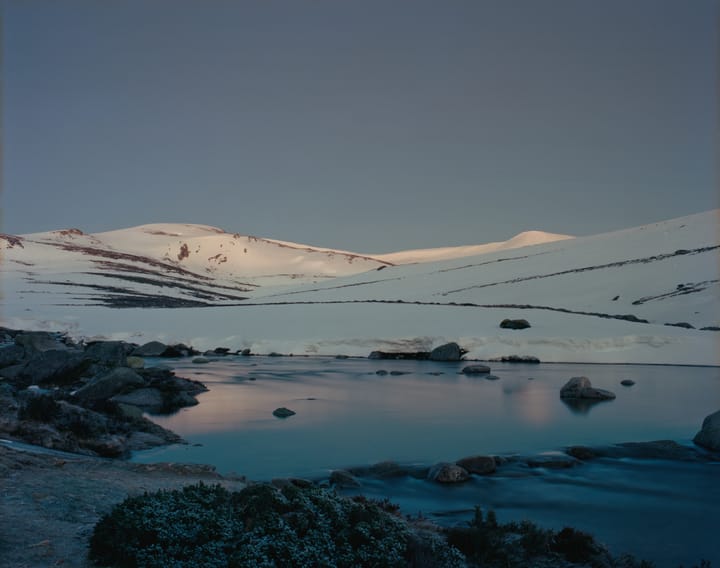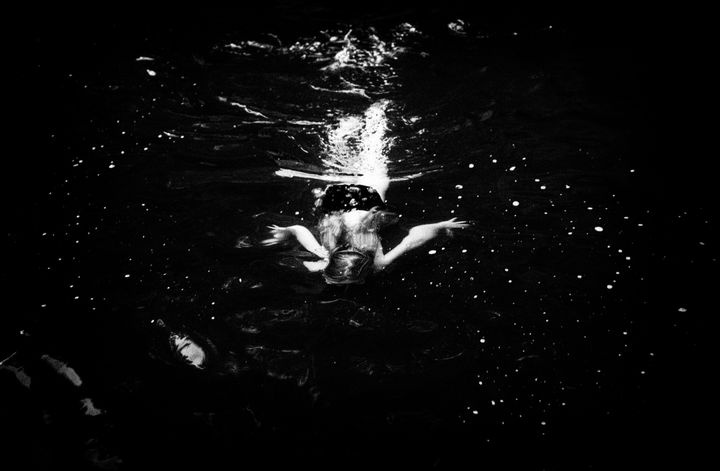2018 was Australia’s hottest year on record. Now, coming off the back of the 2019 ‘climate election’, large swaths of the population are still firmly unimpressed with our nation’s commitment to curbing its reliance on fossil fuels. And rightly so. While PM Scott Morrison flew to the Solomon Islands a few months ago to “show our Pacific step-up in action”, his government’s commitment to climate action has been unimpressive. But as photographs of drought-stricken farmland and wildfires typically underpin the imagery Australia associates with its own contribution to anthropogenic climate change, the reality of the effects span much further and it’s there in the Solomon and other Pacific Islands where the effects of sea level rise are most imminent.
Perhaps no other photographer on Earth is more attuned to this than Vlad Sokhin. For the last six years, his project ‘Warm Waters’ has seen him travel from Alaska to New Zealand, the Pacific and Antarctica, collecting visual evidence on the impacts of man-made global warming – from coastal erosion and rising sea levels to thawing permafrost and changing weather patterns. Now preparing to publish the long-term and multi-continental project as a book, APJ contributor and fellow environment reporter Ashley Crowther caught up with Sokhin from the “front-line of climate change” to learn about the journey behind this leviathan of a project.
_____
For people who don't know your work could you tell us a bit about your background? In particular, your photographic history.
I started doing photojournalism around 10-years ago and did news photography for a few years and then I kind of felt like I was not there anymore. After, I started to pursue long-term projects. So these days, I don’t call myself a photojournalist anymore, but more of a documentary photographer and I’m starting to do some art things as well.
I’ve been working in Africa, the Pacific, and post-Soviet countries mostly. Since 2012 I have been working in the Pacific. For the first three years it was mostly in Papua New Guinea where I worked on a project about gender-based violence, which included witch trials and sorcery. It was a project called “Crying Mery,” and was published in 2014 as a book with PhotoEvidence.
Around the same time, I started to work on Warm Waters. I wanted to cover the whole Pacific Ocean and also include bits of the Arctic and the Southern Ocean as well, including Antarctica. I saw that the Pacific region was a place where not many photographers go, and it’s huge. We don’t hear much about it, but it’s been called many times by different people the “front-line of climate change”.
So far, this has covered the northernmost point of Alaska and the infamous indigenous villages that have been affected by climate change and also the Kamchatka peninsula in Russia, my home country. Finally, most of the countries and territories in the South Pacific.
I’ve been working on Warm Waters for the last six years. So far, there have been four years of shooting and two-years of putting things together and still going back to the Pacific in the meantime. It looks like I’ll be working on this project a bit more and I’m trying to get to Antarctica and connect the North with the South. Next year, I’m preparing to publish Warm Waters as a book.
I know that working on long-term projects requires a lot of self-motivation. What’s your workflow like these days?
I still occasionally work for the media, but mostly it’s more NGO’s, the UN, and development organisations. I like to work on my projects. I feel that with the media nowadays it's a bit challenging to do things. They give you deadlines, three, four, five, or ten days. What can you do in ten days, if you get that? Normally, it’s much less. So I stepped away.
Warm Waters focuses on climate change. Can you explain how the idea formed and what was the primary driver of that motivation?
It started in Papua New Guinea when I was working and visiting several communities where I worked on deforestation and illegal logging. I saw how our planet was being destroyed by greed by companies that wanted to exploit lesser developed nations where, at times, people don’t fully understand the value of their resources and want to sell them quickly.
After this, the project expanded to sea-level rise, coral bleaching, and thawing permafrost. I tried to cover as many topics related to climate change as possible.
However, it was also a personal journey through these places. There’s a lot of reports on climate change from these areas, and I feel like it hasn't been portrayed properly. There’s a lot sensationalism in it because it’s an easy sell. I didn’t feel that many reports were well-balanced. For example, there are reports of sea-level rise that say it is because of climate change. However, we disregard human activities that could have affected the situation.
For example, in Kiribati on the atoll of South Tarawa, there was an island in the middle of the lagoon that disappeared. People kept saying it is sea-level rise. But what happened is that they connected little islands with causeways that disrupted the normal flow of water, which led to the lagoon water levels to rise.
So, I didn't feel as though there were enough balanced reports. I wanted to see for myself what was true and what was not true. However, I still feel like we should listen more and look closer at the scientific data. For us, as photographers or media people, we shouldn’t rush to conclusions that aren’t backed by evidence. I am also talking about myself because I fell into this trap.
Warm Waters, for me, is about nature and people living in these areas that are facing the impacts of climate change and sometimes they are forced to move. I wouldn't call them refugees there aren’t large things like that happening where people are forcefully moving to different countries. It would be better to call them internally displaced peoples (IDP’s). Many islands and parts of the villages are being uninhabitable, so they are moving their homes further inland or to a different place.
Staying on the topic of refugees and IDP's; these days the Australian Government has projected quite a negative sentiment towards refugees. How do you think this could affect potential climate migration in the future?
Australia and the U.S. play a significant role in the Pacific, but also New Zealand, France, and a lot of Asian countries. If there is a need for people to leave their countries permanently because of climate change I’m sure there will be a solution.
The question, however, is that nobody knows how this will affect the people. In most tribal or indigenous societies, the connection to your ancestral land is one of the central values. I saw this when I worked on a story about “nuclear refugees” people that were moved from Bikini Atoll and put on other atolls in the Marshall Islands. They lost their connection, even though they lived in the same country. The sadness that these people have that they cannot go back to their land where all their ancestral graves are, along with the spirits of the land that they believe in.
Imagine, now, if you had to leave the country for a foreign one. At some point, the president of Kiribati came up with the idea about buying a piece of land in Fiji to move some of the people there. But then who will they be seen as? They have no country anymore. If a whole nation becomes homeless what does that mean? And these people might have to live with that. So it will be challenging.
This has all the potential to affect their cultural identity negatively and would lead to so many changes. What are your thoughts on that?
Yes, their cultural identities will completely change, and this will also be a challenge for the countries that accept them. It is one thing to receive hundreds of thousands of people feeling a war like the Syrian one. But can you recognize an entire country as refugees?
It’s tough to say; we are still at the beginning of this process. After speaking with many different scientists and reading reports, I feel that there’s no way to stop this from happening and it will only accelerate in the future. Now, it’s the very beginning, but there will be significant shifts.
What was one of the most challenging moments for you, as a photographer, documenting climate change in the Pacific?
In 2016 in Fiji when super cyclone Winston I arrived the second day after it had passed. I went to a village, and there was a family with nine children with their father. Their mother was killed by a flying tin roof at night while she was trying to save babies. It was such a hopeless moment. The father was completely lost, and he couldn’t understand the situation. His whole life changed, and the entire village was gone. He had no home, nine children with one of them still breastfeeding, and no money. The last bit of money they had was spent on a funeral for his wife.
It was difficult just lifting my camera and asking to photograph. Sometimes you feel these people when you’re trying to do your job, and they let you do it. But then, on this human level, you can feel so much pain. So, it was challenging for me as a human being.
Then there have been some other challenges, like logistics and how to be at the right place at the right time. I’ve been trying to catch the biggest tide of the year in Kiribati almost every February, but it moves. So I follow a lot of moon calendars and tidal forecasts.
So if you’re lucky and if the weather is bad enough then you can see the whole thing.
At the same time, however, after you have calculated all these things you ask yourself: “Do I really want these people to experience this?” That’s another kind of ethical question I’ve faced. I’m hoping this happens to get good images, but then these people are going to suffer, why am I hoping the worst for this country?
But sometimes, you get there, and nothing happens because that’s nature. Actually, for me, that was a big turning point because before I was looking for action and trying to photograph natural disaster zones where there’s always something happening. However, covering climate change, if it’s not a cyclone, how do you capture it?
There were a lot of times where I just had to sit, see, and wait for the right moment. And sometimes nothing happens, and you start to learn by photographing stillness and nothingness, but then something happens. Before I like to think, my eyes were shut, and I was looking for the destruction of climate change because that’s what you mostly see in the media. So on this project, I tried to balance it, so not only showing doom and gloom, but I also wanted to put another emphasis on the fact that our planet is still beautiful, but we are destroying it, and maybe in a 100-years it won't be possible to see the same beauty.
In the past, you have mentioned that one of the positives that you have witnessed while working on Warm Waters was the resilience within these communities, the togetherness, and the support between people who are being affected by these impacts. Can you expand on this?
That was something I tried to focus on. One example, was when Cyclone Pam hit Vanuatu and Tuvalu in 2015. I saw people lose their homes, livelihoods, crops, everything. After, I was in Nepal covering the earthquake and photographing there. But after I had to go back to Vanuatu and a friend of mine contacted me and said “We’re doing a fundraiser event in the capital of Vanuatu. Do you mind if we can show your pictures so people can support things for new schools to being built in Nepal?”
I was shocked; it had only been a month since half the country was wiped out by a cyclone. They then said, “We have three or four crop harvests per year, and most of our houses are made of wood, so it’s easy for us to rebuild them. People in Nepal have lost a lot, so we want to help.” For me, that was just a wow moment. They were helping others when they were in need themselves.
Another example is in Tokelau, a New Zealand dependent territory in the South Pacific. I think it’s the best example I have seen how they manage their resources. When I was in Kiribati for instance, people are practicing open defecation, along with pigs and dogs. So when the high-tide comes, all of it mixes and all the freshwater wells get contaminated. People get sick; kids get sick.
In Tokelau, they designated each island for one purpose. So on one island people live there, on another, there are banks, schools, and other things like solar power plants. Then there’s a big island where all the pigs live and then an agricultural island. It’s all different. If you want to see your pigs you have to take your boat and go there. So when the high-tide arrives, people’s health is protected along with their water wells. There is no mess. I wish countries like the Marshall Islands, Tuvalu, or Kiribati would learn from Tokelau.
Some of you more recent is work from Alaska and the Russian coastlines. The U.S. and Russia are politically at odds regularly. But what are the similarities between the U.S. and Russian communities living on the Pacific coasts?
When I was in a lot of indigenous communities in Alaska they would ask me: “Where are you from?” and I would say, “I’m from Russia,” and they replied, “Oh, uncle, you’re just over the sea.”
In places like Anchorage, Alaska people would talk about politics, but no one in the villages cares about that. They are just living their lives, and their survival depends on everyday tasks. They do talk about climate change and its effect on hunting and fishing and the places they live. The similarities I found that many of the indigenous people didn’t choose the places they lived. They are traditionally nomads, and even in Russia, they were forced by the government to live in certain areas close by to schools otherwise they would face punishment.
That was very challenging for them. The settlements would be built around schools because they didn’t want to be, say 100kms, away when there’s snow. But those places were not chosen wisely. Sometimes these settlements are built on sandbars where it’s always moving – water comes and goes, and the shape of the shore moves as well. It wasn’t their choice, but they have to live there, now they are having to look for better land because of rising seas.
The coastal erosion is crazy. In Newtok village, Alaska they lose around 30m per year, and it’s getting really close to the settlement where they are already talking about relocation. They are also trying to reinforce the coastline with seawalls. However, Newtok is completely moving. New homes are built, but they are already ready to be taken apart and be moved again. No one builds permanent houses anymore because they know that there is no sense in settling permanently.
In Russia, it’s the same. One village on the Kamchatka peninsula, due to the mild weather these days, there is no protection on the coastline by the ice from strong winds. In the past the ice protected the shoreline, now there are just chunks and when strong winds come it lifts the ice chunks. They have lost two and a half streets in the last forty years because of this.
All of this could be part of the normal process of course because coastal erosion is a normal process, but I feel as though it’s intensifying. Now it’s fasters and more intense.
Recently at the COP24 conference, U.S. President Trump’s climate adviser was activity promoting the continued use of fossil fuels. From your perspective after working on Warm Waters, how does that make you feel?
I do not see climate change as humans destroying the planet because we can’t do that. I know, for sure, from recorded history, our planet is more capable of enduring almost anything like meteorites that wiped out nearly all life.
Now, our planet is populated by us and by using fossil fuels, cutting down forests, and everything else we are killing ourselves. We’re not destroying our planet, we’re destroying ourselves, and that’s what people like Trump don’t understand.






















